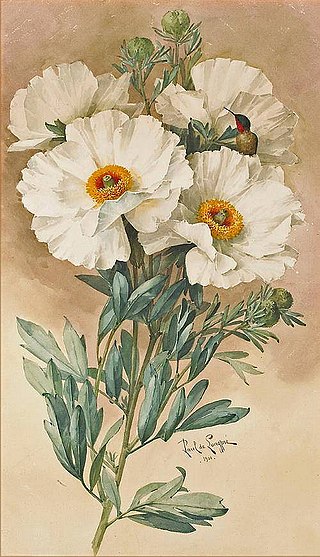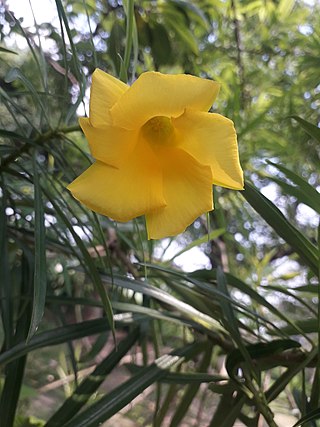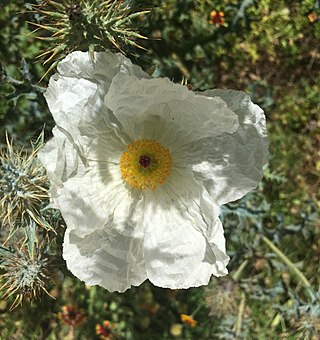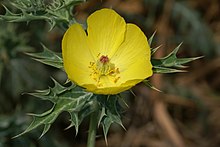
A poppy is a flowering plant in the subfamily Papaveroideae of the family Papaveraceae. Poppies are herbaceous plants, often grown for their colourful flowers. One species of poppy, Papaver somniferum, is the source of the narcotic drug mixture opium which contains powerful medicinal alkaloids such as morphine and has been used since ancient times as an analgesic and narcotic medicinal and recreational drug. It also produces edible seeds. Following the trench warfare in the poppy fields of Flanders, Belgium during World War I, poppies have become a symbol of remembrance of soldiers who have died during wartime, especially in the UK, Canada, Australia, New Zealand and other Commonwealth realms.

Apocynaceae is a family of flowering plants that includes trees, shrubs, herbs, stem succulents, and vines, commonly known as the dogbane family, because some taxa were used as dog poison. Members of the family are native to the European, Asian, African, Australian, and American tropics or subtropics, with some temperate members. The former family Asclepiadaceae is considered a subfamily of Apocynaceae and contains 348 genera. A list of Apocynaceae genera may be found here.

The Papaveraceae are an economically important family of about 42 genera and approximately 775 known species of flowering plants in the order Ranunculales, informally known as the poppy family. The family is cosmopolitan, occurring in temperate and subtropical climates like Eastern Asia as well as California in North America. It is almost unknown in the tropics. Most are herbaceous plants, but a few are shrubs and small trees. The family currently includes two groups that have been considered to be separate families: Fumariaceae and Pteridophyllaceae. Papaver is the classical name for poppy in Latin.

Papaver somniferum, commonly known as the opium poppy or breadseed poppy, is a species of flowering plant in the family Papaveraceae. It is the species of plant from which both opium and poppy seeds are derived and is also a valuable ornamental plant grown in gardens. Its native range was east of the Mediterranean Sea, but now is obscured by ancient introductions and cultivation, being naturalized across much of Europe and Asia.

Sanguinaria canadensis, bloodroot, is a perennial, herbaceous flowering plant native to eastern North America. It is the only species in the genus Sanguinaria, included in the poppy family Papaveraceae, and is most closely related to Eomecon of eastern Asia.

Lamprocapnos spectabilis, bleeding heart or Asian bleeding-heart, is a species of flowering plant belonging to the fumitory subfamily (fumarioideae) of the poppy family Papaveraceae, and is native to Siberia, northern China, Korea, and Japan. It is the sole species in the monotypic genus Lamprocapnos, but is still widely referenced under its old name Dicentra spectabilis, not to be confused with the North American native bleeding heart plants also classified under Dicentra. It is valued in gardens and in floristry for its heart-shaped pink and white flowers, borne in spring.

Epidemic dropsy is a form of edema of extremities due to poisoning by Argemone mexicana.

Sanguinarine is a polycyclic quaternary alkaloid. It is extracted from some plants, including the bloodroot plant, from whose scientific name, Sanguinaria canadensis, its name is derived; the Mexican prickly poppy ; Chelidonium majus; and Macleaya cordata.

Romneya coulteri, the Coulter's Matilija poppy or California tree poppy, is a perennial species of flowering plant in the poppy family Papaveraceae. Native to southern California, USA, and Baja California, Mexico, it grows in dry canyons in chaparral and coastal sage scrub plant communities, sometimes in areas recently burned. It is a popular ornamental plant, kept for its large, showy flowers.

Berberine is a quaternary ammonium salt from the protoberberine group of benzylisoquinoline alkaloids, occurring naturally as a secondary metabolite in some plants including species of Berberis, from which its name is derived.

Cascabela thevetia is a poisonous plant native throughout Mexico and in Central America, and cultivated widely as an ornamental. It is a relative of Nerium oleander, giving it a common name yellow oleander.
Dropsy, more often called edema, is the increase of interstitial fluid in any organ.

Euphorbiaceae, the spurge family, is a large family of flowering plants. In English, they are also commonly called euphorbias, which is also the name of the type genus of the family. Most spurges, such as Euphorbia paralias, are herbs, but some, especially in the tropics, are shrubs or trees, such as Hevea brasiliensis. Some, such as Euphorbia canariensis, are succulent and resemble cacti because of convergent evolution. This family has a cosmopolitan global distribution. The greatest diversity of species is in the tropics; however, the Euphorbiaceae also have many species in nontropical areas of all continents except Antarctica.

Protopine is an alkaloid occurring in opium poppy, Corydalis tubers and other plants of the family papaveraceae, like Fumaria officinalis. Protopine is metabolically derived from the benzylisoquinoline alkaloid (S)-Reticuline through a progressive series of five enzymatic transformations: 1) berberine bridge enzyme to (S)-Scoulerine; 2) (S)-cheilanthifoline synthase/CYP719A25 to (S)-Cheilanthifoline; 3) (S)-stylopine synthase/CYP719A20 to (S)-Stylopine; 4) (S)-tetrahydroprotoberberine N-methyltransferase to (S)-cis-N-Methylstylopine; and ultimately, 5) N-methylstylopine hydroxylase to protopine.

Argemone albiflora, the white prickly poppy, also known as the bluestem prickly poppy or the Texas prickly poppy, is a small erect plant with a decorative white flower with a yellow latex. It is deeply rooted with yellow or red stamens. The plant is known for the sharp prickles on its stem and leaves. The sepals fall off as the flower of this plant grows bigger. It grows in the arid regions of the southern Midwest along roadsides and disturbed pieces of land. Native Americans have long revered this plant for its medicinal and other uses.
In 1998, adulterated mustard oil poisoning in Delhi resulted in widespread dropsy and deaths of 60 people and illness of more than 3000. It was revealed that white oil, a petroleum product was mixed with edible mustard oil. Sale of mustard in loose quantity was banned by a court order, to prevent more health hazards. In September 1998, the ban on packed mustard oil was removed after a Cabinet decision with a condition that the date of packing should be prominently displayed. Even though mustard oil is banned as an edible oil in countries like USA, Canada and EU due to its erucic acid content, the oil is widely used as an edible oil in North India, Pakistan and Nepal.

Cryptopine is an opium alkaloid. It is found in plants in the family Papaveraceae, including Argemone mexicana.

(S)-Cheilanthifoline is a benzylisoquinoline alkaloid (BIA) which has been isolated from Corydalis dubia and Argemone mexicana. (S)-Cheilanthifoline is metabolically derived from (S)-reticuline, a pivotal intermediate in the biosynthesis of numerous BIAs. (S)-Cheilanthifoline is the immediate precursor of the BIA (S)-stylopine ((S)-stylopine synthase/CYP719A20), which is the precursor for the alkaloids protopine and sanguinarine.

Argemone polyanthemos, the crested pricklypoppy, also known as bluestem prickly poppy, pricklypoppy, white prickly poppy, annual pricklypoppy, or as thistle poppy is an annual plant with yellow sap and showy white flowers in the poppy family (Papaveraceae).






















